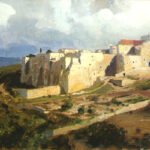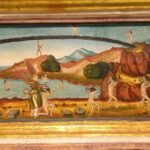I’m dipping into the Canasg catalogue to draw your attention to a really fun, easily learned, arrangement by Paul Ayres of this traditional English carol. If, like me, you sometimes find yourself searching for an upbeat addition to a winter program, this could be the solution!
Here’s Paul’s arrangement. Over a ground of a strong and simple ostinato, the upper voices sing, whistle, and peal bells. The piece may be sung and/or played in a wide range of voicings, with or without extra instruments (e.g. mixed voices, with sopranos singing the optional descant from bar 50, or unison children’s voices accompanied by cellos, with xylophone on the descant….)
I always like to dig a little into where a song comes from and, like so many ‘traditional English’ carols, this one leads to some interesting byways of history.
Wikipedia is a good first port of call. Its entry on I Saw Three Ships tells us immediately that there are many variants of the song, and that it has also been known as ‘As I Sat on a Sunny Bank’. It says, tantalisingly, that the earliest printed version is from the 17th century – but the trail stops there. I would like to find out more about that 17th century version!
On to The New Oxford Book of Carols, ed. Hugh Keyte and Andrew Parrott (Oxford University Press, 1992). The NOBC publishes three variants of the song – and tells us in the footnotes to the first one (No. 148) that the earliest known source is in Forbes’s Cantus (1666). This name rings a bell and, with the help of wikipedia again, I remember that John Forbes of Aberdeen published the first major collections of secular songs in Scotland.
Next I visit the wonderful imslp.org, the Petrucci Library, which contains thousands of facsimiles of music manuscripts (mostly out of copyright). I find the beautiful 1666 edition of John Forbes’s Cantus, Songs and Fancies, and there on pages 46-7 are the lyrics I have been searching for. The song is some distance from the one we sing today: its opening line is ‘All sons of Adam, rise up with me, Go praise the blessed Trinitie’; and the tune is different. But in the second half of the song, there is a very plausible root of the lyrics of the carol:
There comes a ship far sailing then,
Saint Michael was the stieresman (steersman).
Saint John sate in the horn.
Our Lord harped, our Lady sang,
And all the bells of heaven they rang,
On Christ’s Sunday at morn,
On Christ’s Sunday at morn.

The line ‘And all the bells of heaven they rang’ echoes down the centuries into carol no. 148 of the NOBC, whose verses include ‘And all the bells on earth shall ring’ and ‘And all the angels in heaven shall sing’. This NOBC version was itself first published in 1833 by solicitor and antiquarian William Sandys (pronounced ‘sands’), in a volume called Christmas Carols, Ancient and Modern. Songs with broadly similar words and tunes appeared in other Victorian collections – and these printed versions are still sung very widely today.
If you’d like to delve further into the different variants, here are several other websites that regularly repay the effort of spending time there:
- The Vaughan Williams Memorial Library, a wonderful resource of information on folk music, including transcriptions of songs made by collectors of folk song who went around listening to what people sang from memory (see, for example, this version of ‘I Saw Three Ships’ noted by Janet Blunt in Oxfordshire in 1918)
- The Hymns and Carols of Christmas (whose page on I Saw Three Ships is here)
- The Mudcat Cafe (whose page on the origins of I Saw Three Ships here)
You’ll find conjecture about the connection of the song ‘I Saw Three Ships’ to the transport in the 12th century of the supposed relics of the Magi from Constantinope to Cologne Cathedral, via the Mediterranean. And numerous further variants from many parts of the UK and North America. Happy trawling!


